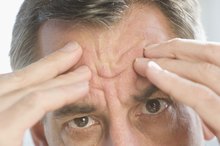Exercise & Its Effect on Sodium Levels
Exercise creates many changes in the body. Depending on the type of exercise and its intensity and duration, exercise can significantly raise the heart rate, use energy (calories) and raise the body's temperature. In order to cool itself, the body responds by perspiring, or sweating. Sweating, in turn, leads to changes in the circulatory system, and the loss of fluids and vital electrolytes. These changes can adversely affect exercise and competition, and can be potentially hazardous to health.
Perspiration
Perspiration is an essential function that helps the body regulate its temperature. Sweat consists primarily of fluids and the electrolyte sodium, as well as smaller amounts of potassium, calcium and magnesium. Although individuals vary, the sodium content of sweat typically ranges from 25 to 75 miliequivalents per liter (mEq/L).
Functions of Sodium
Sodium & Water Balance in the Body
Learn More
Sodium is an electrolyte that helps regulate water levels in and around the body's cells. In addition to regulating the body's water balance, sodium also plays a key role in maintaining normal blood pressure and supports the work of nerves and muscles. A low blood sodium level is referred to as hyponatremia, while a high blood sodium level is referred to as hypernatremia.
Changes in Sodium Levels
As the body perspires during exercise, fluids and electrolytes are lost. If an individual does not consume enough fluids to replace losses during training, dehydration can result. These low fluid volumes can cause the sodium content of the blood to become concentrated, resulting in hypernatremia. In order to prevent dehydration, exercisers often consume large quantities of water. As reported in the Cleveland Clinic Journal of Medicine, with an excessive water intake, the individual may become overhydrated, causing the blood sodium level to become diluted and resulting in exercise-induced hyponatremia. In most cases, exercise-induced hyponatremia is caused by excess free water intake, which fails to replete the sometimes massive sodium losses that result from sweating.
- As the body perspires during exercise, fluids and electrolytes are lost.
- As reported in the Cleveland Clinic Journal of Medicine, with an excessive water intake, the individual may become overhydrated, causing the blood sodium level to become diluted and resulting in exercise-induced hyponatremia.
Symptoms of Hyponatremia
Does Exercise Make You Retain Water?
Learn More
Symptoms of sodium depletion vary depending on the amount of sodium lost and how abruptly it occurs. Symptomatic hyponatremia can occur when plasma sodium drops rapidly over several hours, according to the American College of Sports Medicine. The lower and the faster the sodium falls, the greater the risk of serious complications.
Preventing Sodium and Fluid Imbalances
Hyponatremia is the most common medical complication of ultradistance exercise and is recognized as potentially serious, as reported in the Cleveland Clinic Journal of Medicine. It is difficult to recommend specific fluid and electrolyte intakes since an individual's needs vary depending on his sweating rate, degree of heat acclimation, and diet as well as on the exercise duration and environmental factors (such as heat and humidity) during exercise. The American College of Sports Medicine recommends that individuals develop customized fluid replacement programs that prevent excessive dehydration 1.
The routine measurement of pre- and post-exercise body weights is useful for determining sweat rates and customized fluid replacement programs 1. Monitoring for weight losses that are 2 percent or more from a baseline body weight is advisable. A baseline body weight should be obtained in the morning prior to any exercise and in a well-hydrated state. The individual should drink 20 to 24 fluid ounces of water for every one pound lost.
Consumption of beverages containing electrolytes and carbohydrates can help sustain fluid-electrolyte balance and exercise performance, especially for events lasting more than one hour.
- Hyponatremia is the most common medical complication of ultradistance exercise and is recognized as potentially serious, as reported in the Cleveland Clinic Journal of Medicine.
- The routine measurement of pre- and post-exercise body weights is useful for determining sweat rates and customized fluid replacement programs 1.
Related Articles
References
- Medicine & Science in Sports & Exercise: Exercise and Fluid Replacement
- Consensus Statement of the 1st International Exercise-Associated Hyponatremia Consensus Development Conference, Cape Town, South Africa 2005. Clinical Journal of Sport Medicine. 15(4):208-213, July 2005.
- Institute of Medicine. Water. In: Dietary Reference Intakes for Water, Sodium, Cholride, Potassium and Sulfate, Washington, D.C: National Academy Press, pp. 73–185, 2005.
- Exercise and Fluid Replacement, ACSM Position Stand, American College Of Sports Medicine, Medicine and Science In Sports & Exercise, 2007.
Writer Bio
Michelle Van Doren is a registered dietitian with more than 10 years of experience working in the fitness and health care fields. She has taught weight loss techniques to groups and individuals, instructed diabetics, and serves as a nutrition expert for other health care professionals.









